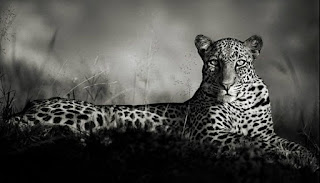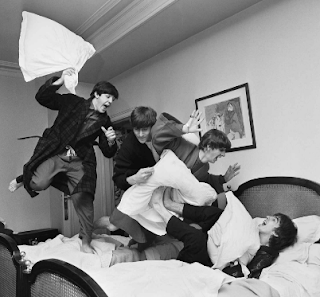Nick Brandt/ Africa
1. Write 3-4 sentences about your reaction to what you read and saw.
My first reaction while reading was how cool it was that Brandt was doing photos of just Africa. My second reaction when I saw the photo of the man holding the elephant tusks was that sadness or a type of sorrow because of the man's head was down, he was in a crouched position, and the filter on the photo. My last reaction was when I was reading and it said how he didn't use a lens to zoom in from a far distance but he got up close to animals that are in the wild that could kill you. I was so amazed but afraid for him.
2. Why is this your favorite photo?
This is my favorite photo because the cheetah is looking right at him and is calm even though he is standing fairly close to them. I also like how he has the photo in black and white to great a dramatic feel. I like how the cheetah is sharp and the background is all blurry.
3. What rules of photography are evident in the photo you selected, be sure to explain the rule to me?
I think balance because you can see the different depths and gradients in the photo but also that it's dark in a way to make it dramatic but not too dark that you can't see the details.
4. What kind of camera and lens does he use and why is this important?
He uses a medium format film camera he also doesn't use a zoom lens. This is important because he gets close to animals that aren't domesticated, which is very dangerous.
5. What is his reason for taking these photos?
He takes these photos to show, "the animals simply in the state of Being. In the state of Being before they are no longer are. Before, in the wild at least, they cease to exist."
6. What is his hope by taking these type of photos?
By taking these photos, he hopes to show the world that what we're doing is hurting the environment and the animals that live in it.
7. What does Nick Brandt have to say about Africa?
He says he "couldn't get over how fast the natural world in Africa was being wiped out".
8. What is Brandt's newest focus with his photography?
His newest focus is staging large prints of animals in dumps and rubble.
9. What was the process he did to create these new images?
His process is taking pictures of animals, printing the images on big boards then, staging them near dumps, rubble, or by a place that is in terrible shape.
10. What effect do you think his work might have?
I think the effect it might have is making people see the parts of Africa that aren't so beautiful and glorious and showing how we are all in a bad spot.
11. How did these new images make you feel?
They made me feel guilty in a way because animals used to roam free in a beautiful place that we ran down and used it for a different purpose that benefited us.
My first reaction while reading was how cool it was that Brandt was doing photos of just Africa. My second reaction when I saw the photo of the man holding the elephant tusks was that sadness or a type of sorrow because of the man's head was down, he was in a crouched position, and the filter on the photo. My last reaction was when I was reading and it said how he didn't use a lens to zoom in from a far distance but he got up close to animals that are in the wild that could kill you. I was so amazed but afraid for him.
2. Why is this your favorite photo?
This is my favorite photo because the cheetah is looking right at him and is calm even though he is standing fairly close to them. I also like how he has the photo in black and white to great a dramatic feel. I like how the cheetah is sharp and the background is all blurry.
3. What rules of photography are evident in the photo you selected, be sure to explain the rule to me?
I think balance because you can see the different depths and gradients in the photo but also that it's dark in a way to make it dramatic but not too dark that you can't see the details.
4. What kind of camera and lens does he use and why is this important?
He uses a medium format film camera he also doesn't use a zoom lens. This is important because he gets close to animals that aren't domesticated, which is very dangerous.
5. What is his reason for taking these photos?
He takes these photos to show, "the animals simply in the state of Being. In the state of Being before they are no longer are. Before, in the wild at least, they cease to exist."
6. What is his hope by taking these type of photos?
By taking these photos, he hopes to show the world that what we're doing is hurting the environment and the animals that live in it.
7. What does Nick Brandt have to say about Africa?
He says he "couldn't get over how fast the natural world in Africa was being wiped out".
8. What is Brandt's newest focus with his photography?
His newest focus is staging large prints of animals in dumps and rubble.
9. What was the process he did to create these new images?
His process is taking pictures of animals, printing the images on big boards then, staging them near dumps, rubble, or by a place that is in terrible shape.
10. What effect do you think his work might have?
I think the effect it might have is making people see the parts of Africa that aren't so beautiful and glorious and showing how we are all in a bad spot.
11. How did these new images make you feel?
They made me feel guilty in a way because animals used to roam free in a beautiful place that we ran down and used it for a different purpose that benefited us.




Comments
Post a Comment